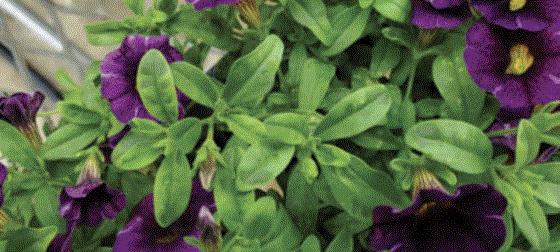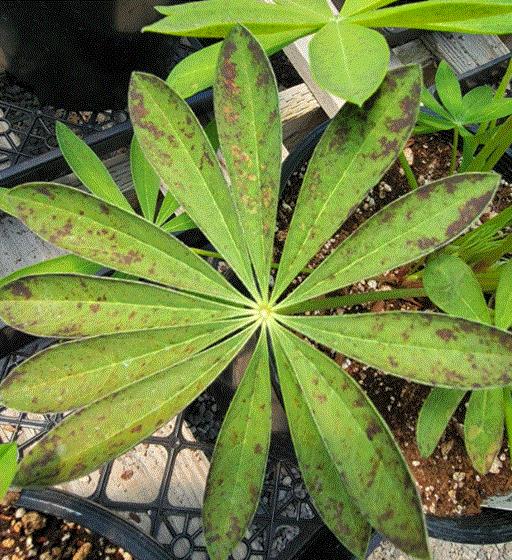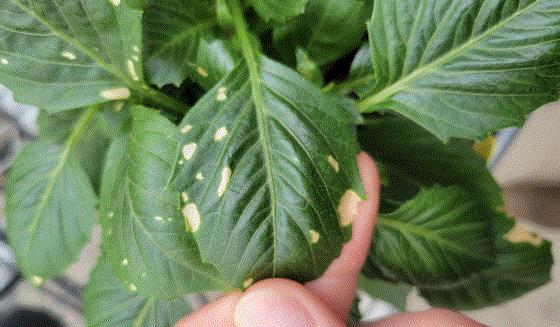Spring Trials Full Tour Video Playlist!
The Ball Publishing bobblehead crew is back from 2025 California Spring Trials and have been debriefing this week—going through our notes and planning all of our upcoming coverage. In fact, we just might have a surprise for you next week! You’ll just have to stay tuned for that.
If you weren’t able to make the trip west this year, we have you covered with individual video for just about every company that displayed in 2025. The shortest of our 23 videos is a minute and a half and the longest is 17 minutes, so you’ll easily be able to fit them into your busy spring schedule. With about 10,000 total views already, I’m guessing many of you have already found the playlist.

What you can expect in each episode is 95% solid information based on our combined 70 years covering the trials and 5% shenanigans (see photo above), because as Bossman Beytes always preaches to us—"If you’re not having fun, you’re not doing it right!" Be sure to watch all the videos to the end, because you never know what’s coming out of our mouths when we think our amazing videographer Osvaldo has already cut the camera …
CAST 2025 FULL VIDEO PLAYLIST

Nick’s Tip of the Week: Abnormal Calibrachoa & Petunia Crops
Each week, I’ll work with my buddy Nick Flax, a technical services expert at Ball Seed, to share a concern that’s come up during one of his numerous calls with growers across North America. This week, he’s discussing possible causes of abnormal growth in petunia and calibrachoa crops. These are reflections based on calls he gets every year.
PROBLEM: As you all know, petunias and calibrachoa make up a major proportion of spring annuals in North American greenhouses every year. With so many small pots, baskets and patio planters full of these genera in production, they represent a lot of the calls I get in spring.
Calibrachoa and petunias are low pH-loving, moderate to high feeders, and are more prone to tospoviruses (like tomato spotted wilt virus [TSWV]) and tobamoviruses (such as tobacco mosaic virus [TMV]) than many other spring annuals. As such, when growers see discoloration or signs of abnormal growth, red flags go up quickly. Since early symptoms of pH issues, low feed and viral disease can look like one another, work quickly to gain insights into the root of the problem and implement the proper management steps ASAP, before things get worse.

NICK’S TIP: Here are a few things to look for so you can rule out potential causes of abnormal growth.
Monitor and Manage Soil pH
If your calibrachoa and petunias are starting to get a bit chlorotic, a quick pour thru, 2:1 test or saturated media extract (SME) can determine whether your growing media pH is in the correct range.
The ideal soil pH range for these crops is 5.4 to 5.8. While they can both tolerate slightly higher pH levels, exceeding 5.8 can predispose both crops to Thielaviopsis infection. Target a soil pH below 5.8 to reduce risk of disease.
When soil pH is much above about 6.0, iron (Fe) uptake will be limited, and interveinal chlorosis will start to appear on the newer growth. If uncorrected, chlorosis will increase in severity and stunting will occur. In extreme cases, tip abortion will occur, and plant growth can completely stall out.
If you do not have a soil pH/EC meter, but you have been growing everything with the same fertilizer and water source, take a look at your high-pH-loving crops like geraniums, marigolds and pentas. If these crops look great and your calis or petunias are suffering, chances are your soil pH is too high.
If high soil pH is the cause of chlorosis (iron deficiency) in your calibrachoas and petunias, switch to a more-acidic fertilizer formulation temporarily until normal growth resumes. Here are some additional considerations if high soil pH is the culprit:
-
If your water source has low alkalinity, fertilizers like 20-10-20 or 21-5-20 are often enough to keep soil pH from creeping up above the optimal range.
-
Moderate to high water alkalinity typically causes soil pH to increase significantly over time, and acid injection is often needed to reduce alkalinity to a level that it can be managed by changing fertilizer formulations.
-
If you have high water alkalinity but acid injection is not feasible, monitor your soil pH regularly and rotate a highly acidic fertilizer like 21-7-7 into your feed program to lower pH when needed.
Drenching with iron chelate is an alternative treatment option for chlorosis due to high-pH-induced Fe deficiency. However, this is more of a Band-Aid for the problem rather than a long-term solution. This may be viable for shorter-term crops, but large hanging baskets or combo planters will likely need multiple iron chelate drenches throughout the crop cycle if your soil pH and/or water alkalinity is consistently high.
Monitor and Manage Soil Electrical Conductivity (EC)
If soil pH is in the proper range for calis and petunias but plants are still a bit chlorotic, chances are your crops are hungry. Checking substrate EC while you are testing pH is the most reliable way to know if you have been feeding enough. Most handheld meters used for testing media pH can also measure EC with the push of a button, so be sure to check both parameters whenever you test.
For example, if pH is normal but plants are chlorotic and substrate EC is below 0.4 mS/cm (based on a pour-thru), this is good supporting evidence that plants are underfed.
If you are not sure what is an appropriate EC range for your calibrachoa or petunias, most culture sheets from breeding companies provide this info for different series.
If your substrate EC is too low, increase your feed rate to 150 to 200% of normal for the next 1 to 2 fertilizer applications and re-test the media EC level. As long as nutrient deficiency symptoms were not too severe, plants should start to resume normal growth within the first couple of fertilizer applications.
Check for Viral Disease
Soil pH and EC are often the quickest and easiest parameters to check first when chlorosis or odd growth symptoms start to appear. However, if both are within normal ranges and you can rule out other abiotic factors like chilling injury or micronutrient toxicity (like boron toxicity, which often presents as stunting, thickening of leaves, increased trichome prominence and yellowing along the leaf margin), virus testing should be your next step.
If you have a notable thrips population in your greenhouse, tospoviruses like TSWV are a definite possibility. Yellow streaking in foliage is a typical early indicator of TSWV in petunias and calibrachoa. Ringspots or necrotic spots often begin developing shortly after streaking starts, especially if crops are subjected to different stress factors like drought or temperature extremes. In-house tests can be done using Agdia ImmunoStrips or you can send samples to a plant disease diagnostic lab if symptoms appear and you have eliminated other possible abiotic factors. If plants test positive, rogue out symptomatic plants and treat thrips ASAP to prevent the virus from spreading.
Tobamovirus symptoms (such as TMV) often start as mottling (easily mistakable for nutrient deficiency), vein clearing, and distortion of newer leaves. As disease progresses, symptom severity increases, affected leaves become necrotic, and the entire plant eventually dies. As with tospoviruses, in-house tests can be performed for tobamoviruses, but lab testing is strongly encouraged as a follow-up to any positive test strip result. Tobamoviruses spread mechanically (plant contact, human handling, contaminated tools/equipment), so exercising good sanitation is critical to prevent spreading these kinds of viruses. Immediately discard plants that test positive for tobamoviruses and scout diligently for new symptoms on nearby crops in the greenhouse.

Lupine Lessons Learned (and Shared)
I was looking through past grower interactions and problems addressed by the technical services team and saw a couple of issues tackled related to worrisome spots on lupine. The spotting appears to be most prominent on older leaves, and my teammates who spoke with the growers said high feed was a commonality. This led to an assertion that the issue was nutrient-related.
Dark spots and splotching on older leaves are common symptoms for Fe/Mn toxicity, so if the crop has been over-fed, this most likely the issue. Keeping a close eye on soil pH and EC is critical, and when corrected, the crop should rebound.

This got me thinking about lupines, because they’re such a stunning impulse plant that shoppers have a hard time passing up at retail. I looked up tips for producing top-quality lupine and found a GROWERTALKS ARTICLE from a decade ago, written by a grower at Walters Gardens in Michigan. Here’s what they had to say regarding culture:
Moisture. Lupines prefer average soil moisture and require good drainage to thrive. Water them thoroughly and allow the soil to dry slightly between waterings. Plants that are held under wet conditions become prone to anthracnose. It’s best to water in the morning and allow the foliage to dry before evening.
Lighting. Lupines require long days to flower. To force them into bloom earlier in the year, day-extension or night-interruption lighting can be effective.
Temperature. If starting your lupines in the fall, grow them under natural temperatures, but maintain air temperatures above 50F (10C) until plants are rooted in. Once they’re well-rooted, they can be shut down for winter and vernalized for 6 to 8 weeks or longer under 40F (4C) in minimally heated greenhouses or unheated cold frames. If growing lupines in spring, grow them cool at 60 to 65F (15 to 18C) constant air temperatures.
Growing Media and Fertility. Lupines prefer to be grown in a well-drained bark-based growing mix, which allows for better drainage. They don’t like heavy soils. A slightly acidic pH of 5.8 to 6.2 is best in production. Lupines are light to moderate feeders. Fertilize with a constant liquid feed of 75 to 100 ppm nitrogen at every irrigation, or 150 to 200 ppm nitrogen as needed. If using a controlled-release fertilizer mixed into the growing media, use at a medium rate of 1 lb./cubic yard. The recommended EC rate using the pour-through method is 2.0 to 2.5.
Pests and Diseases. Lupines can be affected by several insect and disease issues, so it would be wise to maintain a preventative spray rotation on a biweekly basis. Scout for aphids, whiteflies and thrips, treating as necessary. Also watch for downy mildew, powdery mildew, anthracnose and rust. Drenching plants with a broad-spectrum fungicide at transplant can help to prevent disease. Crown and root rots can be prevented by not growing plants wet, especially at night.

Quick Tech Tip: Phytotoxicity on Dahlias
Tech On Demand experts often work with customers who are seeing phytotoxicity symptoms. Here’s one specifically related to phyto issues on a dahlia crop.
When a grower spotted random necrosis on recently-matured dahlia foliage, they reached out for help diagnosing out the problem. After some discussion, they concluded that this foliar damage was most likely caused by insecticidal soap burning the leaves when applied in the middle of the day.

To avoid this type of damage, simply avoid spraying soaps and chemicals during the hot, sunny periods of the day. Instead, spray first thing in the morning or later in the afternoon (but not so late the foliage won't dry before dark). Your crops will thank you!
Podcast Rewind: Biosolutions with Koppert’s Jeremy Webber
One of our most-listened-to Tech On Demand podcasts in the past couple of years is actually a two-part episode focused on biosolutions with Jeremy Webber, the crop team manager at Koppert—the Dutch company that’s been innovating in the biosolutions space for more than 50 years. If you haven’t already listened to these episodes (or need to refresh while planning ahead for 2026), now is a great time to consider how biocontrols will play a role in your future IPM strategies.
Over the course of about an hour total, we discussed why growers are seeking biocontrol strategies more and more, the best gateway pests and bios to start with, how to approach the conventional vs. bio cost discussion, SOPs (standard operating procedures) for a few different common biocontrol scenarios, what every grower should do on Fridays before leaving the greenhouse, why nematodes always work on fungus gnats, eyeless dumb predatory mites, and much, much more.

Jeremy and I started PART ONE discussing the history of Koppert and the company’s vision for 100% sustainable agriculture before moving on to why biosolutions are on just about every greenhouse professional’s mind and why more are considering bios every year. Then I jumped into some rapid-fire questions based on discussions with growers and their most-asked questions—like when to use bios versus conventional pesticides and how costs line up between the two. Throughout part one, Jeremy considered why he (as a former grower) feels biological approaches are critical for our industry’s future, the importance of trust when partnering with a biosolutions supplier, some examples of success moving the industry forward and why bios are a sustainable strategy for any greenhouse operation.
In the SECOND PART, Jeremy and I dug into some more tactical topics like “gateway” pests to start approaching with biological controls, some favorite predators, unexpected lessons learned from the cannabis side of the industry, and why “trials” is possibly not the best word to use when implementing biosolutions on a small scale. Since Jeremy has plenty of greenhouse production experience, I asked him for some absolute no-brainer ways biocontrol strategies can be implemented into any greenhouse immediately—with just-about-guaranteed results.
Before closing, we chatted a bit about what biosolutions in horticulture will look like in the future and why the market is in the right place at the right time.
Be sure to start with EPISODE 134 and then continue with EPISODE 135, because they fit together perfectly.
You can find the Tech On Demand Podcast, brought to you by GrowerTalks on Spotify, Apple Podcasts and just about any other app. You’ll want to subscribe, as well, so you never miss an episode. And take some time to jump back in the archives for more than 170 episodes covering a wide range of topics for greenhouse professionals.

Finish Line … Spring Sales Reporting

Hopefully, this isn’t the only Ball Publishing e-newsletter you receive (we have 10 and they’re all amazing!) and Chris Beytes’ Acres Online hits your inbox regularly. Assuming that’s the case, now’s the time of year he solicits and reports back each week on how spring sales are going across North America. I encourage you to participate! If you haven’t subscribed to Acres, here’s a LINK.
Watch for his weekly Monday morning email asking you to rate the previous week or weekend on a 1 to 10 scale. You can base it on dollars compared to 2024 or just your own gut opinion from having done this for a long time. Chris like to include every state and province, so make your voice heard, because everyone likes to read how things are going for others in our industry. I sure do!
Talk to you next week …
Please feel free to send your comments, constructive criticism and topic ideas to me at bcalkins@ballhort.com.

Bill Calkins
Editor - Tech On Demand
This email was received by you and 25,626 other fine subscribers!
If you're interested in advertising in Tech On Demand, contact Kim Brown ASAP and she'll hook you up.